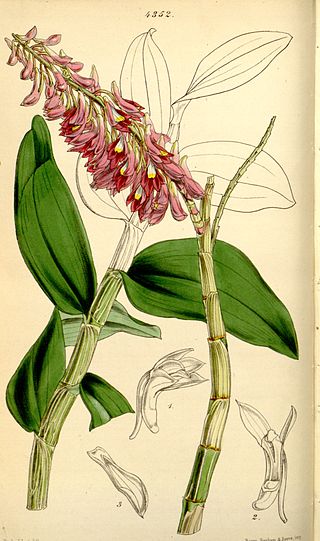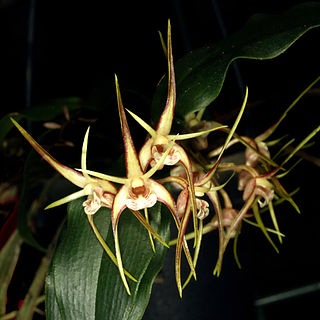
Dendrobium is a genus of mostly epiphytic and lithophytic orchids in the family Orchidaceae. It is a very large genus, containing more than 1,800 species that are found in diverse habitats throughout much of south, east and southeast Asia, including China, Japan, India, the Philippines, Indonesia, Australia, New Guinea, Vietnam and many of the islands of the Pacific. Orchids in this genus have roots that creep over the surface of trees or rocks, rarely having their roots in soil. Up to six leaves develop in a tuft at the tip of a shoot and from one to a large number of flowers are arranged along an unbranched flowering stem. Several attempts have been made to separate Dendrobium into smaller genera, but most have not been accepted by the World Checklist of Selected Plant Families.

Dendrobium gibsonii is a species of orchid native to China, the Himalayas, and northern Indochina.

Dendrobium kingianum, commonly known as the pink rock orchid, is a flowering plant in the orchid family Orchidaceae and is endemic to eastern Australia. It usually grows on rocks, rarely as an epiphyte, and has thin, spreading leaves and spikes of up to fifteen, usually pink flowers in late winter to spring. It is popular in Australian native horticulture and is a commonly cultivated orchid among Australian orchid species growers.

Dendrobium nobile, commonly known as the noble dendrobium, is a member of the family Orchidaceae. Dendrobium nobile is one of the most widespread ornamental members of the orchid family. It is the state flower of Sikkim.

Dendrobium aduncum is a species of orchid. It is native to southern China, the eastern Himalayas, and northern Indochina. It is an epiphyte and grows on the tree trunks of mountain forests.

Dendrobium amabile is a species of orchid endemic to Vietnam.

Dendrobium anosmum, commonly known as the unscented dendrobium, is a species of epiphytic orchid with large purple flowers. It is widespread across Southeast Asia from Sri Lanka to New Guinea, including Indochina, Indonesia, the Philippines, etc. Despite its common name and scientific name, D. anosmum usually has a strong fragrance reminiscent of raspberries.
Dendrobium platycaulon is a species of orchid native to Borneo and the Philippines.

Dendrobium gracilicaule, commonly known as the blotched cane orchid or yellow cane orchid, is an epiphytic or lithophytic orchid in the family Orchidaceae. It has cylindrical pseudobulbs, between three and seven thin leaves and up to thirty often drooping, cream-coloured to yellow or greenish flowers, sometimes with reddish brown blotches on the back. There are two varieties, one occurring in Queensland and New South Wales and the other on some Pacific Islands, including Lord Howe Island.

Dendrobium moniliforme, known as Shihu in Chinese and Sekkoku in Japanese, is a species of orchid. It is native to Japan, Korea, China, the Himalayas, and northern Indochina.

Dendrobium sanguinolentum, the blood-stained dendrobium, is a species of flowering plant in the family Orchidaceae. It is native to Southeast Asia.

Dendrobium secundum, also known as the toothbrush orchid, is a species of flowering plant in the genus Dendrobium of the family Orchidaceae. The common name refers to the fact that all the flowers are on the same side of the stem, much like the bristles all on one side of a toothbrush.

Dendrobium tetragonum, commonly known as the tree spider orchid, is a variable species of epiphytic or lithophytic orchid endemic to eastern Australia. Tree spider orchids are unusual in having pendulous pseudobulbs that are thin and wiry near the base then expand into a fleshy, four-sided upper section before tapering at the tip. There are only a few thin but leathery leaves at the end of the pseudobulbs and up to five flowers on relatively short flowering stems. To allow for the variations in the species there are five subspecies and a variety, some with a unique common name.

Dendrobium thyrsiflorum is a species of orchid, commonly called the pinecone-like raceme dendrobium. It is native to the Himalayas as well as to the mountains of northern Indochina.

Dendrobium aemulum, commonly known as the ironbark feather orchid or white feather orchid, is an epiphytic orchid in the family Orchidaceae and grows on trees that retain their bark, especially ironbarks. It has reddish or purplish pseudobulbs, two to four leathery leaves and up to seven white, feathery flowers. It grows in open forest in Queensland and New South Wales.

Dendrobium philippinense is a species of orchid in the genus Dendrobium that is native to the Philippines, for which it is named, and also to the Island of Guam in the Micronesia.

Dendrobieae is a tribe in the subfamily Epidendroideae, in the family Orchidaceae. The Dendrobieae are mostly tropical, epiphytic orchids which contain pseudobulbs.

Dendrobium dearei is a species of orchid of the genus Dendrobium. It is found in the Borneo and the Philippines. It grows to a maximum size of 7.5 cm.

Dendrobium chameleon is a species of orchid of the genus Dendrobium. It is native to the Philippines and Taiwan. The size of the flowers varies from 2.5 to 3.75 cm.
Dendrobium erosum is a species of orchid of the genus Dendrobium. It is found in Southern Thailand, Malaysia, Sumatra, Java, Sulawesi, Papua and New Guinea, Vanuatu, and the Solomon Islands. It grows to a maximum size of 2.5 mm.

















